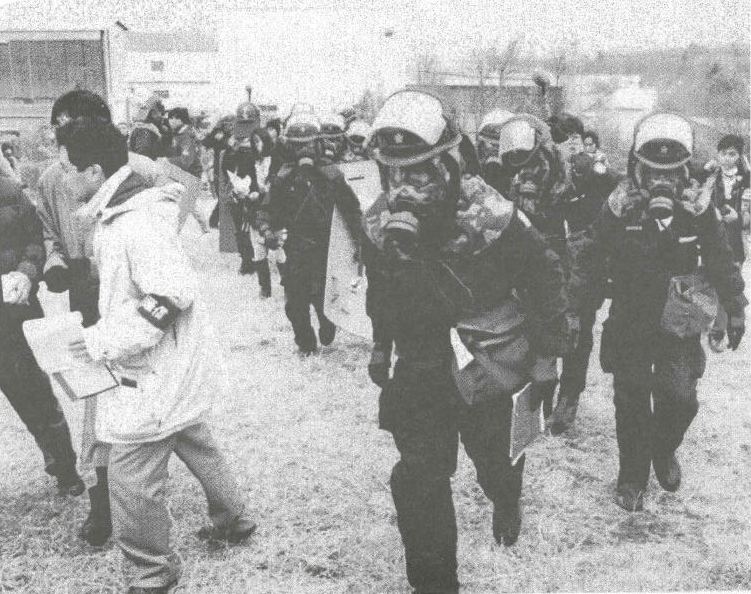It was during the morning rush hour on 20 March 1995.1 Atsushi Sakahara, an office worker in Tokyo, Japan, was riding on the subway on his way to work. Everything for him was as usual that morning, until he realized that something was changing in his body. He felt something wrong with his eyes. He was not able to focus on objects, which made him wonder whether he had forgotten to wash his contact lenses that morning. He moved to the next car, sensing something strange. It was the right decision, because there was a package wrapped in newspaper nearby him in that car that contained sarin gas.2

On that day, five subway trains in Tokyo were attacked at exactly the same time. The attackers were members of Aum Shinrikyo or Aum Supreme Truth, which is a Japanese religious group founded by Shoko Asahara. They released highly poisonous sarin gas on each train, resulting in innumerable numbers of wounded people.3 Atsushi became one of these victims.
His eyes still felt strange even after he left the car to go to the next one. The strange feeling was because of the sarin gas that he breathed in, despite its small amount. At the moment he began to feel his eyes burn, he looked back to the other side of the door he just left; he saw something. One of the men inside the other car started going into fits. That convinced him that it was indeed dangerous to be there, although he didn’t know actually what was happening. Actually, by that time a number of people had already been exposed to the gas, and some of them stood in great danger. He immediately got off the train before his planned stop, and took a taxi to go to his office. However, his sight remained blurred, as if he were seeing everything through a filter. The next thing he did, which may have saved his life, was to see a doctor instead of continuing to work.4 He judged things correctly and acted calmly.

Fortunately, his injury was not a matter of life and death. Nevertheless, he still suffered from its after effects and some psychical trauma, which totally changed the rest of his life. Sarin is a nerve gas with high lethal potential that causes a variety of secondary diseases. It brings about, for example, blurred vision, eye pain, nausea, headache or dyspnea. Then, many of the victims continue to suffer from sicknesses such as headache or eye symptoms long after the attack.5 Atsushi had dysgraphia, fatigue, numbness of arms and legs, and blackouts subsequent to the attack. And the miserable experience deeply damaged his mind. Indeed, many other people also had mental problems, even after their physical problems were completely healed. Sometimes it is called PTSD, or post-traumatic stress disorder, and the patients suffer from nightmares, dizziness, palpitation, or insomnia.6
It was not easy at all for Sakahara to get over these hardships, after being involved in this act of terrorism. However, he succeeded in finding his own solution. He made movies about his experiences as a form of catharsis: a way to remove damaged feelings by emitting them. He retired his job in Tokyo and went to the United States. He then helped to create a short movie called Bean Cake. The film won the Palme D’Or at the Cannes Film Festival in 2001. After that, he returned to Japan and took up a career as a film maker. And currently he is working on his own documentary film on Aum Shinrikyo, the religious cult that was responsible for the sarin gas attack that brought him and others so much pain. He never gives in to his misfortune, and he refrains from hatred against his attackers. In his interview with Japanese media, he said, “I want to believe in humanity. Even if people kill each other in the name of religion, even if people kill each other in the name of a country, or even if people kill each other in the name of race, I still want to believe in humans.”7

The Tokyo sarin gas attack became the first large-scale terrorist chemical gas attack in the world resulting in 12 fatalities and 5,500 injured.8 Many of them are suffering from the effects of the attack even now, more than twenty years after it happened. Atsushi Sakahara’s upcoming film will help a lot of people to know, remember, and tell the next generation not only about this tragedy, but also about people’s power to overcome such painful experiences.
- Patterns of Global Terrorism 1995, 1996, s.v. “Year in Review.” ↵
- “Survivor’s tale: The Tokyo sarin gas attack 20 years later,” Newswires, 2015, EBSCOhost (accessed September 8, 2018). ↵
- Patterns of Global Terrorism 1995, 1996, s.v. “Asia Overview.” ↵
- “Survivor’s tale: The Tokyo sarin gas attack 20 years later,” Newswires, 2015, EBSCOhost (accessed September 8, 2018). ↵
- Tetsu Okumura, et. al., “Report on 640 Victims of the Tokyo Subway Sarin Attack,” Annals Of Emergency Medicine 28 (1996): 131. ↵
- Toshiyuki Ohtani, et al., “Post-traumatic stress disorder symptoms in victims of Tokyo subway attack: a 5-year follow-up study.” Psychiatry & Clinical Neurosciences58, no. 6 (2004): 626; “Survivor’s tale: The Tokyo sarin gas attack 20 years later,” Newswires, 2015, EBSCOhost (accessed September 8, 2018). ↵
- “Survivor’s tale: The Tokyo sarin gas attack 20 years later,” Newswires, 2015, EBSCOhost (accessed September 8, 2018). ↵
- “Asia Overview,” Patterns of Global Terrorism 1995(1996): 3 ↵



28 comments
Melanie Fraire
It’s truly terrifying to see how some people get a kick out of injuring others, I can’t imagine how terrible this incident must’ve been to those who experienced it especially since it was done in such a crowded and public area. While this was my first time hearing about this incident it was still very interesting to read about and I’m glad one of the victims is slowly making something good out of such tragic event by raising awareness on it.
Saira Locke
It’s crazy to me how terrorists feel as though gas attacks will solve any problems. I have never heard of this terrorist attack, but it is really sad that people in this world can do horrific things like this to others even innocent people. I hope that all terrorist groups in the future become less violent because these acts cause pain to both the intended and the innocent and it is not fair for those not in the fight to suffer.
Cassandra Sanchez
This was really interesting to read about since I had never heard of this event before. It is terrifying to see how powerful chemicals can truly be towards humans and the long lasting effects they can have on our bodies. It is crazy how Sakahara was able to act fast and recognize that something was off when he was on the train and decide to get help immediately. I also admire how later on, he created a film to raise awareness for this event and its victims.
Mark Dominguez
A very fascinating article, although short, it was very informative about the terror attack done by the Aum Shinrikyo. Prior to reading this article, I had never heard about this event, it was very interesting to get more of a first-hand account of it. It is also remarkable that Atsushi Sakahara is still willing to believe in humanity after unfortunately being a part of this tragic event.
Aaron Peters
Although the article was short, it did provide good background on the Aum Shinrikyo Terror attacks done by Shoko Asahara. I appreciate a more personal perspective on the attacks, since usually in large scale terror attacks, the individuals are often so numerous they are forgotten in the way history remembers such events. For one of Japan’s few large terror attacks, it’s good to document everyone’s personal stories from it.
Antonio Coffee
The fact that he was able to maintain his faith in humanity even after all he went through is amazing. I had never heard of these gas attacks and this was really surprising to me. I want to look further into this series of attacks to see what was going on. Sakahara was smart to go see a doctor and should be looked to as an inspiration for how we can still have faith in humanity even when things go bad.
Diego Terrazas
I have heard of this attack before. I wonder what the cult’s purpose was. It is admirable that the survivor Atsushi Sakahara still had the willpower to believe in humans even after a terrorist attack. I could not imagine what kind of person I would be after such an attack… I certainly would not be the same person. I also believe westerners should know about this attack.
Robert Rees
My only complaint about this article is that it is rather short, however that only encourages me to do my own research into the attack, the cult responsible for it, as well as the victims affected by their actions. I had at first excepted this article to be primarily focused on the Aum Shinrikyo cult and it’s leader Shoko Asahara, however i was pleasantly surprised to read that Atsushi Sakahara, one of the victims was the main focus of the article.Overall, while brief the article does manage to inform the reader quite a bit about Atsushi Sakahara, and leaves me wondering why the Daila Lama was photographed along side Shoko Asahara.
Micaela Cruz
Although this article was rather short to me, it was interesting to learn about these gas attacks. I had not previously heard about the Tokyo sarin gas attacks so reading about not only how harmful the gas was to people but also how it was an attack planned by a religious group was one aspect that I found the most shocking. Overall a good read.
Ysenia Rodriguez
I have never heard of these attacks before, nor have I heard of Atsushi Sakahara, but I think it’s wonderful that he was able to get treatment before his injuries from the gas became fatal. The quote you provided from Sakahara was really inspirational considering he fell victim to such a dangerous terrorist attack. Nonetheless, his words are truly inspiring. Despite the pain some people wish to cause to the world, he still wants to believe in mankind. I hope this kind of mindset echoes throughout the world today.